
Eupithecia nimbicolor is a moth in the family Geometridae first described by George Duryea Hulst in 1896. It is found in North America from eastern Newfoundland and Labrador to western British Columbia and from Alaska to Arizona.

Eupithecia cimicifugata is a moth in the family Geometridae first described by Pearsall in 1908. It is found in North America, including Alberta, Ontario, Saskatchewan, Kentucky, Maryland and South Dakota.
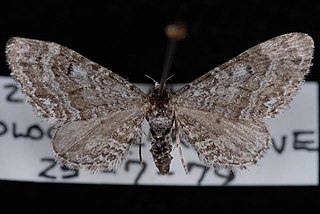
Eupithecia perfusca is a moth in the family Geometridae first described by George Duryea Hulst in 1898. It is found in western North America.
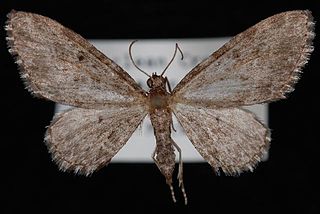
Eupithecia lachrymosa is a moth in the family Geometridae first described by George Duryea Hulst in 1900. It is found in North America from central Saskatchewan west to southern Vancouver Island, north to British Columbia and Alberta and south to California.
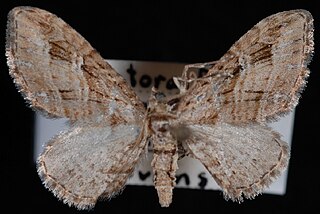
Eupithecia niphadophilata is a moth in the family Geometridae first described by Harrison Gray Dyar Jr. in 1904. It is found in North America from British Columbia and western Alberta south to New Mexico.
Eupithecia subcolorata is a moth in the family Geometridae first described by George Duryea Hulst in 1898. It is found in western North America, from British Columbia south to Arizona and New Mexico.

Eupithecia niveifascia is a moth in the family Geometridae first described by George Duryea Hulst in 1898. It is found in North America from south-western Alberta west to Vancouver Island, north to northern coastal British Columbia and south to New Mexico.
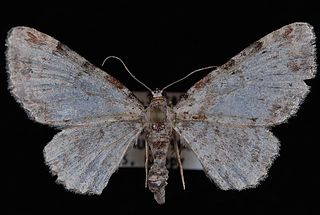
Eupithecia mutata, the spruce cone looper or cloaked pug, is a moth in the family Geometridae. The species was first described by Pearsall in 1908. It is found in the northern Atlantic and New England states in North America. In Canada, the range extends from Nova Scotia to northern Ontario.
Eupithecia classicata is a moth in the family Geometridae first described by Pearsall in 1909. It is found in the US state of Arizona and the Mexican state of Durango.
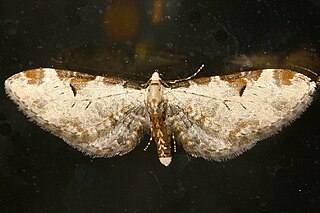
Eupithecia nevadata is a moth in the family Geometridae first described by Alpheus Spring Packard in 1871. It is found in western North America.
Eupithecia sabulosata is a moth in the family Geometridae first described by James Halliday McDunnough in 1944. It is found in the US state of California.
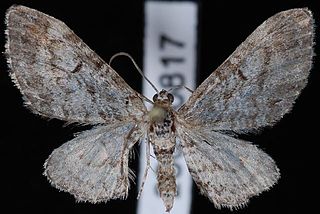
Eupithecia graefi, or Graef's pug, is a moth in the family Geometridae. The species was first described by George Duryea Hulst in 1896. It is found in North America from south-western Alberta west to Vancouver Island, north to Alaska and south to California. The habitat consists of wooded areas.

Eupithecia placidata is a moth in the family Geometridae first described by Taylor in 1908. It is found in western North America from British Columbia south to California.
Eupithecia biedermanata is a moth in the family Geometridae first described by Samuel E. Cassino and Louis W. Swett in 1922. It is found in the US state of Arizona.

Eupithecia russeliata is a moth in the family Geometridae first described by Louis W. Swett in 1908. It is widespread in North America, including Alberta, California, Kentucky, Maine, Maryland, Minnesota, New Brunswick, Newfoundland and Labrador, North Carolina and Nova Scotia.
Eupithecia zygadeniata is a moth in the family Geometridae first described by Alpheus Spring Packard in 1876. It is found in North America, with records from Texas and Montana.

Eupithecia olivacea is a moth in the family Geometridae first described by Taylor in 1906. It is found in North America from British Columbia south through Washington and Oregon to California.

Eupithecia spermaphaga is a moth in the family Geometridae first described by Harrison Gray Dyar Jr. in 1917. It is found in western North America from British Columbia, through Oregon and Washington to Nevada and California.
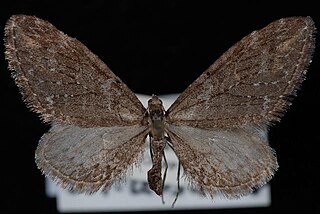
Eupithecia scabrogata is a moth in the family Geometridae first described by Pearsall in 1912. It is found in western North America from British Columbia to California and Arizona.
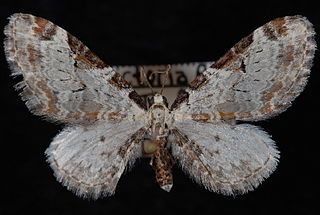
Eupithecia ravocostaliata, the tawny eupithecia or great variegated pug, is a moth in the family Geometridae. The species was first described by Alpheus Spring Packard in 1876. It is found in northern New York and the New England states, extending across Canada from the Maritime provinces to Vancouver Island and down the west coast as far as the San Francisco Bay region.














